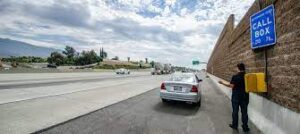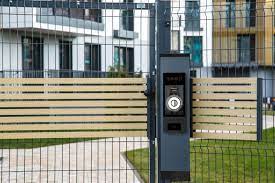Throughout history, communication has been a cornerstone of human progress. From the earliest smoke signals to the advent of the telegraph, the ability to connect with one another has driven technological innovation. In this exploration of call boxes, we journey through time to uncover the evolution and enduring importance of these communication devices.

Types of Call Boxes
Firstly, call boxes serve as vital communication devices, primarily designated for emergency situations or requesting assistance. These essential tools come in the follwing forms:
- Police Call Box: These are typically found in urban areas and serve as a means for the public to contact law enforcement quickly. They often have a blue light on top and a direct line to the local police department.
- Railway Call Box: Located along train tracks or railway stations, these call boxes allow railway personnel to communicate about safety, signal issues, or emergencies related to train operations.
- Highway Emergency Call Box: Positioned along highways and major roads, these call boxes are used by motorists to request help in case of accidents, breakdowns, or emergencies. They connect users directly to highway patrol or roadside assistance services.
- Campus Emergency Call Box: Found on college or university campuses, these call boxes provide students and staff with a way to contact campus security or emergency services in case of safety concerns or medical emergencies.
- Airport Emergency Call Box: Airports have call boxes in various areas, including parking lots and terminals, for passengers and employees to report security issues, lost items, or medical emergencies.
- Hospital Call Box: Hospitals may have call boxes at entrances or parking areas for patients, visitors, or staff to request assistance, especially during non-operating hours.
- Park or Trail Call Box: Located in recreational areas, parks, or hiking trails, these call boxes are for reporting accidents, injuries, or suspicious activities to park rangers or authorities.
- Industrial Plant Call Box: Within manufacturing or industrial facilities, call boxes are used for internal communication, alerting personnel to safety concerns, or requesting assistance in emergencies.
- Prison or Correctional Facility Call Box: Inmates and staff in correctional facilities can use these call boxes to communicate with security or request medical attention when needed.
- Hotel Emergency Call Box: Hotels may have call boxes at key locations like lobbies, elevators, or parking areas, allowing guests to reach hotel staff or security for assistance.
What is an Apartment Call Box?

Imagine this scenario: You’re a visitor, standing at the entrance of an apartment complex, eager to reach your friend on the fifth floor. Without an apartment call box, your options would be limited, perhaps involving a string of unanswered phone calls or awkwardly waiting for someone to exit or enter the building.
An apartment call box transforms this experience. It is an access control device, akin to a digital doorman, that empowers visitors to connect with residents inside the building. It’s a simple yet highly effective solution to the age-old question of how to gain access to a multi-unit residential property.
In apartment complexes, residents commonly utilize call boxes for the following purposes:
- Buzz in visitors without needing to personally reach the front entrance.
- Providing access to delivery couriers to facilitate package deliveries.
- Independently managing visitor access, reducing dependence on doormen or front desk staff.
The fundamental purpose of an apartment call box is to facilitate communication between visitors and residents. By pressing the designated button or inputting the resident’s code, a visitor can initiate contact with someone inside the building, typically on the resident’s mobile phone or landline. This interaction enables the visitor to announce their arrival, request entry, or simply establish a line of communication with the resident.
Let’s break down the key components and functionalities of an apartment call box:
- Visitor Interface: At the heart of the call box is the visitor interface, which includes a keypad or buttons for inputting codes, a call button to initiate communication, and often a built-in speaker and microphone.
- Resident Directory: Many call boxes feature a resident directory, either as a physical list or a digital display. Visitors can search for a resident’s name and use the directory to call them directly.
- Access Codes: Residents typically have unique access codes that visitors can enter to connect with them. These codes ensure that only authorized individuals gain entry.
- Call Routing: When a visitor makes a call, the call box routes it to the resident’s specified phone number. This can be a landline, mobile phone, or even a dedicated intercom system within the resident’s unit.
- Voice and Video Communication: Some advanced call boxes offer video communication, allowing residents to see and speak with visitors before granting access.
- Remote Access Control: Residents can remotely grant or deny access to visitors from their phone or intercom system.
- Keyless Entry: In some cases, apartment call boxes are integrated with keyless entry systems, allowing residents to remotely unlock doors for visitors.
Are Resident Call Boxes and Intercoms the Same?
Intercoms and resident call boxes are related communication devices, although they serve distinct purposes. An intercom is primarily designed as an internal voice communication system for use within a single building or a small cluster of buildings. In contrast, a resident call box serves as a communication device that facilitates interactions between visitors and residents in apartment buildings and similar settings.
A resident call box can utilize either a telephone line intercom or a video intercom system to establish communication between visitors and residents. The key differentiation lies in how communication is initiated and how residents can verify the identity of the visitor. While intercoms can serve various communication needs, such as facilitating conversations between different rooms or areas within a building, resident call boxes are specifically tailored to connect visitors with residents in a secure and efficient manner.
Traditionally, call boxes have been recognized as bulkier and more rugged pieces of equipment intended for outdoor use. In contrast, intercoms were typically lighter-duty devices designed for indoor applications. However, it’s worth noting that modern intercom systems have evolved to be sleek and are also suitable for outdoor use, blurring the line between the two. This evolution ensures that both intercoms and resident call boxes can effectively meet their respective communication requirements while offering enhanced durability and versatility, depending on the specific needs of the setting.
MOCAM 3 Units Apartment Video Intercom System

- 1pcs outdoor camera and 3pcs indoor monitor video intercom doorbell system, supporting 1 building which has 3...
- 7 Inch LCD press key screen,door answering, monitoring and unlock, dual-way intercom Mute door intercom with door bell...
- 16 different kinds of door bells chimes.Volume, brightness and contrast are adjustable. Fashion and nice design,which...
Last update on 2025-04-05 / Affiliate links
Enhance the security and convenience of your apartment building with the AMOCAM 3 Units Apartment Video Intercom System. This advanced intercom system is designed to provide seamless communication and access control, ensuring the safety of your residents while adding a touch of modern elegance to your property.
Package Includes:
- 3 x 7-inch Color Monitors
- 3 x Outdoor Doorbell Cameras
- 3 x Power Adapters
- 3 x Mounting Brackets
- Electronic Door Lock Controller
- User Manual
- Mounting Screws and Accessories
Key Features:
- Crystal Clear Video: The AMOCAM Video Intercom System delivers high-resolution video, allowing residents to see and identify visitors clearly, day or night, thanks to its infrared night vision feature.
- Two-Way Communication: Communicate effortlessly with visitors through the built-in microphone and speaker. The hands-free, full-duplex communication ensures smooth conversations.
- Multiple Unit Support: This system supports up to three separate units, making it ideal for small to medium-sized apartment buildings. Each unit comes with a 7-inch color monitor, a doorbell camera, and a sturdy metal casing.
- Access Control: Grant or deny access to your building with the push of a button. The included electronic door lock controller lets you remotely unlock the door for authorized visitors, providing added security.
- Easy Installation: Installation is straightforward, thanks to the included user-friendly manual and all necessary mounting hardware. The system is designed to be compatible with existing wiring, reducing installation time.
- Weatherproof Design: The outdoor camera is built to withstand various weather conditions, ensuring its durability and performance in rain, snow, or extreme temperatures.
- Expandable: The AMOCAM system is expandable, allowing you to add more units or integrate it with other security features for a comprehensive security solution.
- Multi-language Support: The user interface supports multiple languages, making it accessible to a diverse range of residents.
Invest in the AMOCAM 3 Units Apartment Video Intercom System and give your residents peace of mind knowing they have a reliable and sophisticated access control and communication system at their fingertips. With crystal-clear video, hands-free communication, and robust security features, this intercom system is a smart choice for any apartment building.
Wireless Call Boxes
Wireless call boxes have become an increasingly popular choice due to their flexibility and ease of installation. Unlike traditional wired call boxes, which rely on physical connections, wireless systems utilize radio frequencies in the VHF (Very High Frequency) or UHF (Ultra High Frequency) business band radio spectrum. This technology allows for seamless communication between the call box and the central system without the need for extensive wiring.
One notable advantage of wireless call boxes is their compatibility with a wide range of VHF or UHF business band portable or fixed-base radios. This versatility means that existing radio infrastructure can often be integrated with wireless call box systems, making them a cost-effective solution for many organizations.
However, it’s important to note that, in the United States, many wireless call boxes require an FCC (Federal Communications Commission) license to operate legally. This ensures that they adhere to established regulations and do not interfere with other licensed users of the radio spectrum. Some wireless call boxes, though, are designed to operate on specific FCC license-free business frequencies, simplifying the licensing process.
Wireless call boxes are ideal for situations where the required communication distance exceeds the range of the wireless call box. In such cases, external antennas can be employed to extend the range, ensuring reliable connectivity even in larger areas. Additionally, in the FCC-licensed frequency range, radio repeaters can further amplify the signal and extend the range substantially.
For those looking for an eco-friendly solution, there are wireless call boxes designed to operate on solar power. These solar-powered call boxes are truly wireless, as they don’t require any power lines to be connected to them. They harness energy from the sun, store it in batteries, and use it to power the call box and communication equipment. This not only reduces the environmental impact but also makes installation more straightforward, as there’s no need to run power lines to the call box location.
IP Call Box
An IP call box, short for Internet Protocol call box, is a sophisticated communication device that harnesses the power of Internet Protocol (IP) technology to provide voice communication capabilities in various settings, particularly in outdoor, remote, or challenging environments. Unlike traditional analog call boxes, IP call boxes leverage network connectivity to offer enhanced features and flexibility.
Here are some key aspects and details about IP call boxes:
- Network Connectivity: IP call boxes are designed to connect to IP networks, such as local area networks (LANs) or the broader Internet. They typically use Ethernet cables or Wi-Fi for network connectivity. This enables them to transmit voice data over data networks efficiently.
- Versatility: These call boxes are highly versatile and find applications in a wide range of settings. They are commonly used in public spaces, parking lots, university campuses, industrial facilities, and remote areas where establishing traditional communication infrastructure may be challenging.
- Emergency Communication: IP call boxes often serve as emergency communication tools. They allow users to quickly summon help or report emergencies by simply pressing a button or initiating a call. Emergency call boxes are strategically placed in areas where immediate assistance may be required, enhancing safety and security.
- Access Control: In addition to emergency use, IP call boxes are employed for access control purposes. They can be integrated into security systems, allowing visitors or personnel to request access to a secured facility. Users can communicate with security personnel or an access control center, and access can be granted remotely if approved.
- Remote Monitoring: Many IP call boxes come equipped with cameras and speakers, enabling two-way audio and video communication. This feature is particularly useful for security applications, as it allows operators to visually verify the situation at the call box location and communicate with the user in real time.
- Integration: IP call boxes can be seamlessly integrated into existing IP-based communication systems. They can communicate with IP phones, IP video surveillance cameras, and other networked devices, providing a comprehensive solution for security and communication needs.
- Scalability: IP call boxes can be easily scaled and expanded to meet the specific requirements of a location. Additional call boxes can be deployed as needed, and they can all be centrally managed through the IP network.
- Power Options: Some IP call boxes are designed to be energy-efficient and may incorporate solar panels for power generation. This feature makes them suitable for off-grid locations, as they don’t rely on traditional power sources.
- Compliance: Depending on their usage and location, IP call boxes may need to comply with certain regulations and standards, especially if they are used for emergency communication. Compliance ensures that they meet specific performance and safety criteria.
Overall, IP call boxes represent a modern and flexible solution for various communication and security needs. Their ability to leverage IP technology, integrate with existing systems, and provide reliable communication in challenging environments makes them valuable tools in enhancing safety, security, and convenience.
